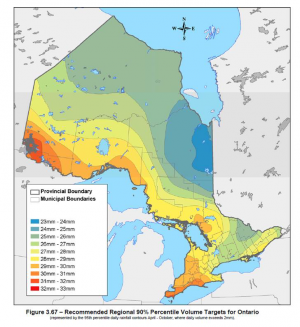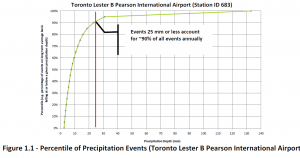Difference between revisions of "Runoff volume control targets"
Jenny Hill (talk | contribs) m |
Jenny Hill (talk | contribs) m (→See also) |
||
| (4 intermediate revisions by the same user not shown) | |||
| Line 1: | Line 1: | ||
| − | [[File:90th percentile.png|thumb|Recommended regional 90th percentile volume targets for Ontario]] | + | [[File:90th percentile.png|thumb|Recommended regional 90th percentile volume targets for Ontario<ref> Aquafor Beech, EarthFX. Runoff Volume Control Targets for Ontario Final Report. 2016:125. http://www.downloads.ene.gov.on.ca/envision/env_reg/er/documents/2017/012-9080_Runoff.pdf. Accessed September 11, 2017.</ref>]] |
[[File:Pearson_Graph.png|thumb|Typically designed to handle the smaller, most frequent storm events, LID practices in Southern Ontario are usually sized according to the 90th percentile event]] | [[File:Pearson_Graph.png|thumb|Typically designed to handle the smaller, most frequent storm events, LID practices in Southern Ontario are usually sized according to the 90th percentile event]] | ||
Typically designed to handle the smaller, most frequent storm events, LID practices in Ontario are usually sized according to the 90th percentile event. In many areas this translates into events that are < 30 mm in depth. Note that 25 mm is considered to be a suitable representation of the ‘first flush’ volume, and that controlling this amount of runoff may provide stormwater engineers with control over 90 % of the mean annual pollutant load <ref>Pitt, R. 1999. Small Storm Hydrology and Why it is Important for the Design of Stormwater Control Practices. In: Advances in Modeling the Management of Stormwater Impacts, Volume 7. Computational Hydraulics International, Guelph, Ontario and Lewis Publishers/CRC Press. 1999</ref>. | Typically designed to handle the smaller, most frequent storm events, LID practices in Ontario are usually sized according to the 90th percentile event. In many areas this translates into events that are < 30 mm in depth. Note that 25 mm is considered to be a suitable representation of the ‘first flush’ volume, and that controlling this amount of runoff may provide stormwater engineers with control over 90 % of the mean annual pollutant load <ref>Pitt, R. 1999. Small Storm Hydrology and Why it is Important for the Design of Stormwater Control Practices. In: Advances in Modeling the Management of Stormwater Impacts, Volume 7. Computational Hydraulics International, Guelph, Ontario and Lewis Publishers/CRC Press. 1999</ref>. | ||
| Line 8: | Line 8: | ||
'''Volume capture and treatment''' - Also referred to as `treatment and release`, where the volume capture and treatment directly aims at reducing surface water impairment through treatment of the specified volume, often referred to as a “water quality volume”.<ref>MOECC (2018)</ref>}} | '''Volume capture and treatment''' - Also referred to as `treatment and release`, where the volume capture and treatment directly aims at reducing surface water impairment through treatment of the specified volume, often referred to as a “water quality volume”.<ref>MOECC (2018)</ref>}} | ||
| + | |||
| + | ==See also== | ||
| + | *[[Understanding rainfall statistics]] | ||
| + | |||
---- | ---- | ||
Latest revision as of 16:36, 4 December 2019

Typically designed to handle the smaller, most frequent storm events, LID practices in Ontario are usually sized according to the 90th percentile event. In many areas this translates into events that are < 30 mm in depth. Note that 25 mm is considered to be a suitable representation of the ‘first flush’ volume, and that controlling this amount of runoff may provide stormwater engineers with control over 90 % of the mean annual pollutant load [2].
Runoff Volume Control Target (RVCT)[edit]
"The means to achieve the RVCT includes:
Retention - where the captured volume shall be ultimately infiltrated, evapotranspired or re-used and the specified volume will not later be discharged to sewer networks (with the exception of internal water re-use activities) or surface waters and does not therefore become runoff, and
Volume capture and treatment - Also referred to as `treatment and release`, where the volume capture and treatment directly aims at reducing surface water impairment through treatment of the specified volume, often referred to as a “water quality volume”.[3]
See also[edit]
- ↑ Aquafor Beech, EarthFX. Runoff Volume Control Targets for Ontario Final Report. 2016:125. http://www.downloads.ene.gov.on.ca/envision/env_reg/er/documents/2017/012-9080_Runoff.pdf. Accessed September 11, 2017.
- ↑ Pitt, R. 1999. Small Storm Hydrology and Why it is Important for the Design of Stormwater Control Practices. In: Advances in Modeling the Management of Stormwater Impacts, Volume 7. Computational Hydraulics International, Guelph, Ontario and Lewis Publishers/CRC Press. 1999
- ↑ MOECC (2018)
